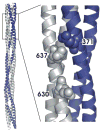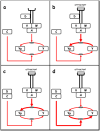The three adaptation systems of Bacillus subtilis chemotaxis
- PMID: 18774298
- PMCID: PMC3532902
- DOI: 10.1016/j.tim.2008.07.003
The three adaptation systems of Bacillus subtilis chemotaxis
Abstract
Adaptation has a crucial role in the gradient-sensing mechanism that underlies bacterial chemotaxis. The Escherichia coli chemotaxis pathway uses a single adaptation system involving reversible receptor methylation. In Bacillus subtilis, the chemotaxis pathway seems to use three adaptation systems. One involves reversible receptor methylation, although quite differently than in E. coli. The other two involve CheC, CheD and CheV, which are chemotaxis proteins not found in E. coli. Remarkably, no one system is absolutely required for adaptation or is independently capable of generating adaptation. In this review, we discuss these three novel adaptation systems in B. subtilis and propose a model for their integration.
Figures





References
Publication types
MeSH terms
Substances
Grants and funding
LinkOut - more resources
Full Text Sources
Molecular Biology Databases

